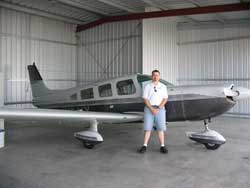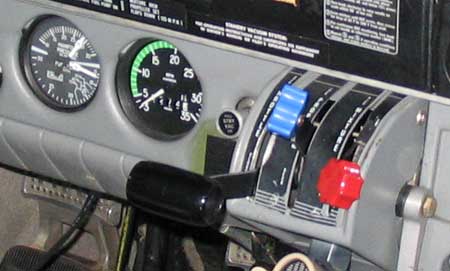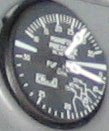 A pilot certificate is often referred to as a “License to Learn.” This could not be more true. My newest target is the Cherokee Six. Here I explore the world of the constant-speed prop.
A pilot certificate is often referred to as a “License to Learn.” This could not be more true. My newest target is the Cherokee Six. Here I explore the world of the constant-speed prop.
As I’ve mentioned before, my father is a partner in a Piper Cherokee Six 300, I am about to become a partner in that very airplane. As part of the FAA requirements, I must earn a flight instructor’s sign-off to fly a “high performance” airplane, one with more than 200 horsepower (the 300 horsepower Cherokee Six certianly qualifies). In addition to the FAA’s requirement, I must also satisfy our insurance’s requirements of 20 hours in “type.” Basically, this means I have to have 20 logged hours in a PA-32, the model designation for the the Cherokee Six/Lance/Saratoga family.
My flight training was done in a Piper Cherokee Warrior, or a PA-28. While similar, the PA-28 is not the same “type” as the PA-32. Piper designed the PA-32 based on the PA-28, but it is a completely different airframe. Although it shares much of the same layout as the PA-28, the insurance requirement stands. My good friend, Todd, is serving as my CFI for this task.
Todd and I have made three flights so far, for a total of 5.3 hours, leaving me 14.7 hours remaining (not that I’m counting).
You’ve Added A Lever!

The single biggest difference in the Cherokee Six compared to the Warrior is the addition of a constant speed prop. The concept behind a constant speed prop is rather complex, although the operation is very simple.
A constant speed prop has the ability to change pitch, as opposed to a fixed-pitch propeller (found on the Warrior). Inside the cockpit the blue lever between the throttle (black) and the mixture (red) sets the RPM of the propeller. The govenor, located inside the spinner, adjusts the pitch of the blades to keep a constant RPM, hence the name “constant-speed propeller.” For more on how a constant-speed prop works, refer to the Wikipedia article.
The pilot typically sets the prop lever three times, once for take-off, once for climb, and once for cruise. For a pilot used to a fixed-pitch prop, the throttle (which controls RPM in those aircraft), is set to full for takeoff and climb, and not adjusted until cruise. This is not the case with a constant-speed prop. Immediately after take-off, the pilot will pull the throttle back to a predetermined setting, in the Cherokee Six it’s 25 inches. I say inches, because in a constant-speed prop airplane, the throttle won’t affect the RPM, since the propeller will maintain the same speed by changing it’s pitch.
Every airplane equipped with a constant-speed prop also has a manifold pressure gauge (shown below). In our airplane, it shares the same dial with the fuel-flow indicator.

This guage mesures the barometric pressure inside the engine, basically, it lets’ you know how much power the engine is producing. The engine of the Cherokee Six is only to be run at maximum power for a short period of time, hence why we reduce power immediately after takeoff. As you climb, the outside air gets thinner, therefore the engine has less air to burn, and develops less power. The manifold pressure will drop as you climb. The pilot should then increase the throttle to maintain the proper indication on the manifold pressure indicator. It should be noted that when you climb high enough, full throttle may not produce the desired climb power, at that point, you maintain full throttle until you reach your cruise altitude.
So What’s Up with the Blue Lever?
The propeller control (the blue lever), is used to set the RPM, as I mentioned above. This allows the pilot to change the propeller’s characteristics depending on his or her demand. For example, when climbing, you want a propeller that will spin quickly and take small, powerful bites out of the air. When at cruise, you want a quiet, slower propeller that will take larger bites out of the air.
Immediately after takeoff, the throttle is pulled back, followed by the prop control. In our plane, it’s back to 2,500 RPM for the best climb performance. Unlike the manifold pressure, the RPM will remain constant as you climb, therefore, the pilot does not have to readjust the propeller control until he/she is ready to change the RPM.
This is done when transitioning from climb to cruise. In the Cherokee Six, we pull her back to 2,300 RPM for a nice quiet cruise at 75% power. The same as in takeoff, the throttle is adjusted first, then the propeller. A good rule of thumb is never set the manifold pressure higher than the RPM, this would be like flooring your car in 5th gear to get up a hill. You’re not going to get any better performance, and you’re putting a huge drain on the engine.
Do you adjust the RPM for a decent? No. You don’t need to. Simply pull the power back to the desired level and the airplane will begin to decend. The RPM will remain constant, but the propeller will be taking much larger bites with much less power, therefore causing you to decend.
Is It Hard?
There have been times I swore I never wanted to add anything more to do when I was flying. Adding a constant-speed prop to the mix does mean a bigger climb, cruise, and decent checklist, but it’s not difficult to get used to. I regularly bounce between the Cherokee Six and the Warror or C172, and don’t have any problem.
Having a good instructor is paramount. If you’re unsure of the concept of the constant-speed prop, ask your CFI or a fellow pilot to take you up and demonstrate it. Once you see it in action, it will all make sense. Don’t worry, it’s a breeze.
I’ve been making some changes to the site, and think I’ve got comments working properly now, so if you have a question or a comment about this article, drop me a line!

But is this rule in the 6 POH?
A good rule of thumb is never set the manifold pressure higher than the RPM, this would be like flooring your car in 5th gear to get up a hill. You’re not going to get any better performance, and you’re putting a huge drain on the engine.
Actually that line came directly from my CFI – since then, I’ve learned that “rule” is wrong.
Actually in the PA32 POH there is a cruise power to RPM settings table for the altitude you are cruising at. This table includes manifold/rpm settings for 55%, 65%, and 75% power cruising. In a number of cases these settings may go (as they say) over squared – where the manifold pressure exceeds the rpm.
There are a number of pilots that live by the “never go over squared rule”. There are other pilots that believe the manufacturer (Piper in this case), may know more about their aircraft performance specs than an old codger who has been flying for 50 years on your local airfield.
Yeah, I vote for the POH over the codger. It is published and approved by the FAA – the codger may not be 🙂
I came across your website and it was quite helpful as i am learning in a pa28-180. i have 5 kids and would like to buy a cherokee 6. I have about 25 hours and am wondering if I could handle the 6. what do you think?
Hey guys. Thanks for the article and comments. I am helo pilot in the Navy, and have just rejoined the fixed wing world after several years away. The local flying club has a piper arrow, so trying to brush up on my constant speed prop procedures. Great article.
-James